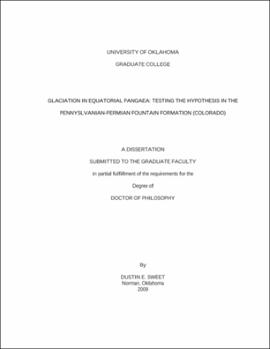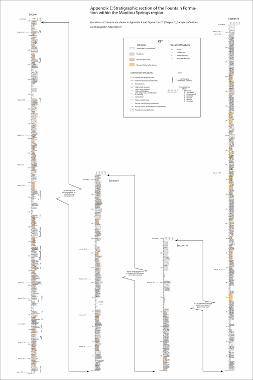| dc.contributor.advisor | Soreghan, Gerilyn S | |
| dc.creator | Sweet, Dustin Edman | |
| dc.date.accessioned | 2019-04-27T21:37:20Z | |
| dc.date.available | 2019-04-27T21:37:20Z | |
| dc.date.issued | 2009 | |
| dc.identifier | 99353289602042 | |
| dc.identifier.uri | https://hdl.handle.net/11244/319183 | |
| dc.description.abstract | Recently, Soreghan et al. (2007, 2008) suggested that Unaweep Canyon of western Colorado was initially carved by Late Paleozoic equatorial glaciers that reached modest elevations (<1000 m). Furthermore, Soreghan et al. (in press) suggest that the Permian Cutler Formation cropping out at the mouth of Unaweep Canyon represents proglacial and ice-contact deposition. These new hypotheses are important because they challenge previously proposed models and they provide new ideas for Late Paleozoic climate states, chiefly low-latitude, low-elevation glaciation. However, if these hypotheses are valid, then the Cutler-Unaweep glacial system should not have been a singular event and other glacial systems should have been present within the ancestral Rocky Mountains. This study tests the hypotheses that glacial and proglacial conditions influenced sedimentation in the Late Paleozoic Fountain Formation where it crops out along the east flank of the Front Range of Colorado. In addition, data providing constraints on basin evolution in the Manitou Springs, Colorado, region and estimates of global sea level change are presented. The work is organized such that each chapter represents a stand-alone entity. | |
| dc.description.abstract | Chapter 2 | |
| dc.description.abstract | Sedimentologic, stratigraphic and structural data indicate that the Fountain Formation at Manitou Springs consists of three tectonostratigraphic units, herein termed the lower, middle and upper Fountain units. The lower and middle Fountain units were deposited in a fan-delta setting adjacent to the active ancestral Ute Pass fault. The lower is thin and predominantly characterized by depositional stability as rcorded by abundant well-developed, deeply-rooted paleosols. The middle Fountain unit reflects fan progradation and highland rejuvenation as a result of increased activity of the ancestral Ute Pass fault. This activity was likely the result of a basinward splay of the ancestral Ute Pass fault with reverse dip-slip motion as indicated by (1) exhumation of the lower Paleozoic Sawatch Formation and (2) fault-parallel folding. The upper Fountain unit reflects deposition in a NW-SE-trending, braided-river system and appears to post-date movement on the ancestral Ute Pass fault. Lithostratigraphic correlation allows for a Latest Pennsylvanian-early Permian age for the upper Fountain unit, thus constraining cessation of the ancestral Ute Pass fault to middle- to late Pennsylvanian time. | |
| dc.description.abstract | The Fountain Formation was deposited within a NW-SE oriented structural trough (i.e. Woodland Park trough) that separated the ancestral Front Range into a northern block (i.e. ancestral Front Range block) and a southern block (i.e. Ute Pass uplift). The Woodland Park trough was bounded on its southern margin by the ancestral Ute Pass fault which was active throughout deposition of the lower two Fountain tectonostratigraphic units, during which time sediments were shed northward across the ancestral Ute Pass fault into a marine environment. By the time of deposition of the upper Fountain unit, movement on the ancestral Ute Pass fault had ceased or dramatically decreased. During this time, the Fountain Formation records predominantly axially oriented braided-stream deposition. | |
| dc.description.abstract | Comparison of the timing and kinematic history of the ancestral Ute Pass fault with other documented reverse and strike-slip faults of the ancestral Rocky Mountains suggests that: 1) cessation of faulting within the ancestral Rocky Mountains displays a slight east-to-west younging, but the crude age resolution of adjacent basin fill also allows for the possibility of relatively synchronous cessation of faulting, and 2) kinematics of all faults examined are consistent with a NE-SW oriented maximum horizontal compressional stress field. These inferences contrast with the proposed Laurentian-Gondwanan diachronous closure models for the ancestral Rocky Mountains, which require rotation of the maximum horizontal stress orientation through time and pronounced east-to-west younging of faulting. Rotation of the horizontal stress field may be recorded in multi-stage, kinematic histories of faults but multiple faults require study to assess this model. Age constraints on post-tectonic units of the ancestral Rocky Mountains, such as the upper Fountain Formation tectonostratigraphic unit defined herein, are poor and further refinement would greatly aid understanding of the enigmatic tectonics of these ancient mountains. | |
| dc.description.abstract | Chapter 3 | |
| dc.description.abstract | Sand- and granule-filled polygonal fractures are present on bedding surfaces within the equatorial Fountain Formation (Pennsylvanian-Permian, Colorado). The surfaces are areally extensive (> 120,000 m2) and occur within inferred braided-river deposits. The fractures penetrate downward into coarse sandstone to granule conglomerate and range from 3-55 cm and 13- >220 cm in width and depth, respectively. At one locality (Manitou Springs), both fracture fill and polygon interiors display a grain-supported texture and contain <14% clay; additionally, the fracture fill is microbrecciated. At the other locality (Loveland), both the fracture fill and polygon interiors display a grain-supported texture and contain <3.5% clay. | |
| dc.description.abstract | The polygonal fractures are inferred to have formed as frozen ground experienced thermal contraction induced by repeated cooling events. Owing to the equatorial location of the Fountain Formation, we suggest that diurnal, rather than seasonal, temperature variations provided the repeated cooling mechanism. Alternative causes of polygonal fracturing, such as desiccation of clay-rich sediments or thermal contraction of evaporite minerals, are untenable because the hosting strata contain minimal clay (<14%) and are framework-supported, indicating that there was insufficient space for either clay or evaporite minerals. A thermal contraction origin for these features implies that the equatorial Fountain Formation experienced at least two episodes of remarkably cold conditions. Furthermore, using maximum reasonable stream gradients (~0.02) between the polygonally fractured surfaces and the shoreline (gauged from shallow-marine deposits of the Denver basin), the fractures formed at relatively low elevation (≤ 1800 m). | |
| dc.description.abstract | Chapter 4 | |
| dc.description.abstract | Scanning Electron Microscopy (SEM) of first-cycle quartz grains from the equatorial, Pennsylvanian-early Permian Fountain Formation reveals microtextures that resulted from fracturing during depositional transport, even after diagenetic overprinting occurred under moderate burial conditions (up to 3.5 km depth and 100°C). Depositional transport microtextures can be grouped based on fracture process into: 1) high-stress fractures, consisting of fractures created through sustained high-shear stress, such as grooves, deep troughs, and gouges, and are inferred to occur predominantly during glacial transport; 2) percussion fractures, consisting of fractures created by grain-to-grain contact during saltation or traction flow, such as randomly oriented v-shaped cracks and edge rounding, and are inferred to occur predominantly during saltation and/or traction flow; and 3) polygenetic fractures, such as conchoidal fractures, arc-shaped steps, linear steps and linear fractures, occur under a wide range of transport processes and thus indicate no environmental significance. Using a ternary diagram that distinguishes high-stress, percussion, and polygenetic fracture types, data from this study demonstrate that quartz grains from the Fountain Formation exhibit microtextures similar to both Quaternary till and glaciofluvial deposits, suggesting that periods of upland glaciation occurred in the Fountain Formation provenance region (Ute Pass uplift). | |
| dc.description.abstract | The frequency of high-stress fractures versus stratigraphic level shows three peak intervals (I, II, & III). These intervals are inferred to record the presence of ice within the Ute Pass uplift and are correlative with polygonally fractured bedding paleosurfaces within the Fountain Formation inferred to reflect cold-temperature weathering. Moreover, the peak intervals are roughly coeval to inferred episodes of ice maxima from high-latitude localities. Employing geologically reasonable stream gradients and estimated transport distance, elevation of the ice terminus is constrained to <1500 m. These data suggest that upland glaciers episodically existed within this equatorial setting and further use of this technique may reveal more evidence of ice in other proximal deposits of the ancestral Rocky Mountains, as well as other systems of various geologic ages. | |
| dc.description.abstract | Chapter 5 | |
| dc.description.abstract | At Manitou Springs, Colorado, the lower ~ 240 meters of the Fountain Formation is composed of successive continental-marine cycles. Each cycle is characterized by alluvial-fan deposits overlain by a marine progradational package. A thin cobble conglomerate marks the base of marine strata and is inferred to represent a transgressive lag. Furthermore, each of these lags can be traced down depositional dip throughout the study area. The above field relationships allow for a minimum calculation of the magnitude of sea-level change because: 1) a minimum horizontal distance of transgression can be measured from the mapped transgressive lag deposits; and 2) the slope of the surface over which transgression progressed can be estimated through paleohydraulic analysis of the fluvial deposits. | |
| dc.description.abstract | Magnitudes of sea level change over six successive cycles were calculated using an estimated depositional slope of 0.005; results suggest a minimum of 10-18 m of change. A large eustatic component is inferred for these six cycles because each marine package is separated throughout the study area by alluvial packages; conversely, inferred autogenic cycles of the Fountain Formation have alluvial components that grade laterally into marine strata. Tectonic pulses occur over too long a time frame to have produced these higher-frequency cycles. | |
| dc.description.abstract | Marine strata of the lower Fountain Formation have yielded Morrowan-Atokan conodonts (Idiognathoides sinuatus). Few estimates of the magnitude of sea-level change exist for this time period, but incised valley depths suggest 20-45 m of eustatic sea-level change and modeling of ice-volume and facies models suggest 40-60 m of sea-level change. Our estimates are absolute minimums and the method does reflect some sensitivity to variations in slope, such that an order-of-magnitude change in slope results in ~100 m of sea-level change. Nevertheless, the range given by our method approaches other estimates and provides a new method for estimating magnitudes of sea-level change. | |
| dc.description.abstract | Glacio-eustasy is the result of ice growth and ice melt due to cyclical climate change. The data presented here indicate low levels of interglacial ice melt when compared to other times in the late Paleozoic. However, high- and low-latitude records indicate that cold conditions may have prevailed during the Morrowan-Atokan possibly suggesting that the estimates may reflect cooler interglacials with high-volume ice that experienced reduced melt. | |
| dc.format.extent | 182 pages | |
| dc.format.medium | application.pdf | |
| dc.language | en_US | |
| dc.relation.requires | Adobe Acrobat Reader | |
| dc.subject | Glaciers--Pangaea (Supercontinent) | |
| dc.subject | Geology, Structural--Colorado--Manitou Springs | |
| dc.subject | Geology, Stratigraphic--Pennsylvanian | |
| dc.subject | Geology, Stratigraphic--Permian | |
| dc.subject | Sedimentary rocks | |
| dc.title | Glaciation in equatorial Pangaea: Testing the hypothesis in the Pennsylvanian-Permian Fountain Formation (Colorado) | |
| dc.type | text | |
| dc.type | document | |
| dc.type | image | |
| dc.thesis.degree | Ph.D. | |
| ou.group | Mewbourne College of Earth and Energy::ConocoPhillips School of Geology and Geophysics | |

